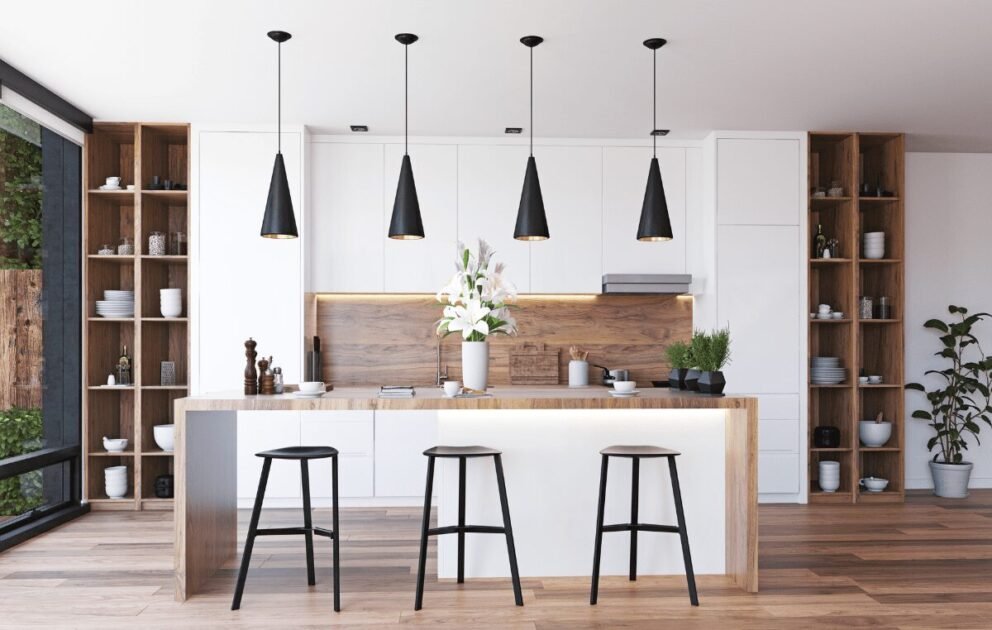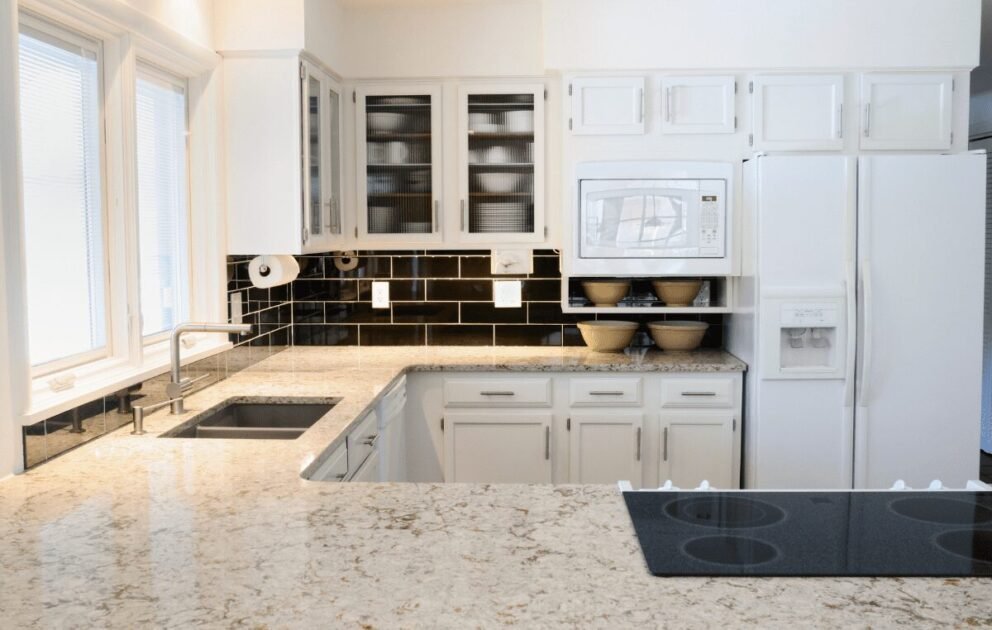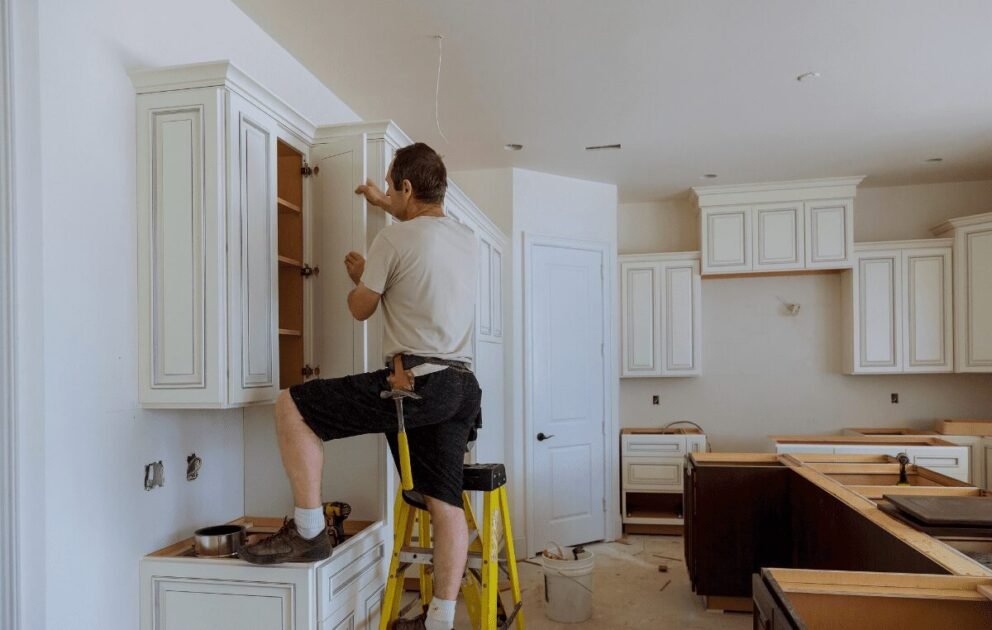To measure kitchen cabinets perfectly in 11 steps, follow these guidelines carefully. We will guide you on how to measure your kitchen cabinets accurately to ensure a perfect fit.
Whether you are replacing your cabinets or planning a renovation, taking precise measurements is essential. By adhering to the following steps, you can avoid costly mistakes and ensure a seamless installation process. So, let’s get started on measuring your kitchen cabinets accurately.
1. Understanding The Basics Of Kitchen Cabinet Measurements
Accurate measurements are the foundation of any successful kitchen cabinet installation. Whether you’re renovating your kitchen or designing a new one, understanding the basics of kitchen cabinet measurements is crucial. In this section, we’ll explore why accurate measurements are essential, key measurements to consider, and common measurements that adhere to industry standards. By mastering these fundamentals, you’ll be well-equipped to measure your kitchen cabinets perfectly, ensuring a seamless and functional installation process.
Why Accurate Measurements Are Essential For Kitchen Cabinets
Accurate measurements are the backbone of a successful kitchen cabinet project. By taking precise measurements, you can ensure that your cabinets fit perfectly within the space available. This allows for proper functionality and maximizes the storage potential of your kitchen. Inaccurate measurements can lead to ill-fitting cabinets, wasted space, and ultimately, a less functional kitchen. Therefore, investing time and effort into obtaining accurate measurements is essential for a successful kitchen cabinet installation.
Key Measurements To Consider: Height, Width, And Depth
When it comes to measuring kitchen cabinets, there are three key dimensions to consider: height, width, and depth. These measurements determine how well the cabinets will fit within the designated space, as well as how much storage they can provide. It’s important to note that these measurements should be taken in a way that accounts for any obstructions, such as baseboards, trim, or uneven flooring. By accurately measuring the height, width, and depth of your kitchen cabinets, you can ensure a seamless installation process that aligns with your design vision.
Common Master Kitchen Cabinet Measurements And Industry Standards
The kitchen cabinet industry adheres to certain standards and common measurements that simplify the installation process. By following these standards, you can ensure compatibility and avoid unnecessary complications. Some of the common measurements to consider include:
| Measurement | Standard Range |
|---|---|
| Base Cabinet Height | 34.5 inches (87.63 cm) |
| Upper Cabinet Height | 30-42 inches (76.2-106.68 cm) |
| Base and Upper Cabinet Depth | 24 inches (60.96 cm) |
| Base and Upper Cabinet Width | vary based on design and preference |
These measurements serve as a starting point for ensuring compatibility with standard kitchen cabinet units. However, it’s crucial to note that they can be customized based on your specific needs and design preferences. Keep in mind that these measurements are just a guide, and it’s essential to take accurate measurements of your kitchen space and specific cabinet requirements before finalizing any decisions.
With a solid understanding of the basics of kitchen cabinet measurements, you’re well on your way to achieving the perfect fit and functional design. By emphasizing accuracy, considering key measurements, and being aware of industry standards, you can measure your kitchen cabinets efficiently and confidently. In the following sections, we’ll guide you through the step-by-step process of measuring your kitchen cabinets perfectly, ensuring a successful installation and a beautiful, functional kitchen.
2. Tools You’ll Need For Accurate Cabinet Measurements
When it comes to measuring kitchen cabinets, having the right tools is crucial for accurate results. Without the proper tools, you may end up with incorrect measurements, which can lead to ill-fitting cabinets. To ensure precise measurements and a successful cabinet installation, here are the essential tools you’ll need:
Measuring Tape
The measuring tape is the most important tool for accurately measuring your kitchen cabinets. It allows you to measure the length, width, and height of the cabinets. When choosing a measuring tape, opt for one with a locking mechanism for precise measurements. A tape with both metric and imperial units is also recommended for convenience.
Other Essential Tools
In addition to the measuring tape, several other tools can assist you in obtaining accurate cabinet measurements. These tools include:
- Pencil: Use a sharp pencil to mark your measurements directly on the cabinets or a piece of paper.
- Notebook or Paper: Keep a notebook or a stack of paper nearby to record your measurements. This will help you stay organized and prevent any confusion later on.
- Straightedge: A straightedge is useful for measuring straight lines and ensuring your measurements are even and level. You can use a ruler or a carpenter’s square as a straightedge.
- Level: A level is crucial for ensuring your cabinets are perfectly horizontal and vertical. This tool helps you determine if the cabinets are installed straight and aligned correctly.
Recommended Measuring Techniques For Accuracy
While having the right tools is essential, using proper measuring techniques is equally important to achieve accurate cabinet measurements. Here are some recommended techniques to ensure precision:
- Take Multiple Measurements: Instead of relying on a single measurement, take multiple measurements for each dimension to ensure accuracy. This helps account for any slight variations or irregularities in the cabinet’s shape.
- Measure Twice, Cut Once: The old saying holds when it comes to measuring kitchen cabinets. Double-check your measurements before making any cuts or purchasing cabinets to avoid costly mistakes.
- Use a Level Surface: Place the cabinets on a level surface to obtain accurate measurements. Uneven surfaces can distort measurements and lead to ill-fitting cabinets.
- Measure from the Highest Point: When measuring the height of the cabinets, always start from the highest point, such as the ceiling or floor. This ensures that your cabinets will fit perfectly, even if the ceiling or floor is uneven.
By following these tips and using the necessary tools, you’ll be well-prepared to measure your kitchen cabinets accurately. This will save you time, money, and frustration in the long run, ensuring a seamless installation process.
3. Step-by-step Guide To Measuring Cabinet Height
Accurate measurements are crucial when it comes to installing kitchen cabinets. To ensure a perfect fit and seamless installation, it is important to measure the height of the cabinets correctly. In this step-by-step guide, we will walk you through the process of measuring cabinet height in 11 easy steps.
Determining The Starting Point For Measuring Height
Before you start measuring the height of your kitchen cabinets, it’s important to determine the starting point for your measurements. The starting point is usually the floor, but in some cases, it may be the top of the existing cabinets or the bottom of a soffit. Identify the specific starting point in your kitchen and note it down.
Measuring The Overall Height, Including Any Molding Or Trim
To get the accurate overall height of your kitchen cabinets, including any molding or trim that may be attached, follow these steps:
- Place the end of a tape measure at the determined starting point and extend it vertically along the side of the cabinet.
- Ensure the tape measure is straight and not slanted. Measure from the starting point to the top edge of the cabinet, including any molding or trim.
- Record the measurement accurately in inches or centimeters.
Adjusting For Flooring Variations Or Uneven Surfaces
In some cases, your kitchen floor may have variations or uneven surfaces that can affect the height measurements of your cabinets. To compensate for these variations and ensure a level installation, follow these steps:
- Identify the lowest point on the floor where the cabinet will be installed.
- Measure the distance from the starting point to the lowest point on the floor.
- Calculate the difference between the overall height measurement and the measurement of the lowest point on the floor.
- Add or subtract this difference from the overall height measurement, depending on whether the lowest point is higher or lower than the starting point.
- Record the adjusted height measurement.
By following these 11 steps, you will be able to measure the height of your kitchen cabinets accurately. Taking precise measurements ensures a seamless and professional-looking installation, whether you are installing new cabinets or replacing existing ones.

4. Measuring Cabinet Width: Ensuring A Proper Fit
Measuring the width of your kitchen cabinets is a crucial step in achieving a perfect fit for your kitchen remodel. In this section, we will guide you through the process of measuring cabinet width, whether you are working with individual cabinets or multiple cabinets, or need to account for countertop overhangs or filler space.
Measuring The Width Of Individual Cabinets
When measuring the width of individual cabinets, follow these simple steps:
- Begin by opening the cabinet door or drawer fully. This will allow you to measure the outermost edges of the cabinet accurately.
- Using a tape measure, measure the width from one side of the cabinet to the other. Make sure to measure across the widest point, which may include any decorative trim or molding.
- Write down the measurement in inches or centimeters, whichever is your preferred unit of measurement.
Repeat this process for each cabinet in your kitchen. Taking accurate measurements for each cabinet will help ensure a precise fit during installation.
Calculating The Total Width For Multiple Cabinets
If you have multiple cabinets lined up together, you’ll need to calculate the total width. Follow these steps:
- Start by measuring the individual widths of each cabinet, as explained earlier.
- Add together the widths of all the cabinets to get the total width. Make sure to include any filler pieces or spaces left between the cabinets.
- Write down the total width measurement. This will be crucial when ordering countertops or planning the installation.
By accurately calculating the total width, you can ensure a seamless and cohesive look for your kitchen cabinets.
Making Allowances For Countertop Overhangs Or Filler Space
When measuring cabinet width, it’s important to consider countertop overhangs or any filler spaces that may be present. Follow these steps to make the necessary allowances:
- Measure the overhang of your countertop by extending the tape measure from the edge of the cabinet to the desired overhang point.
- For filler space, measure the width of the space where a filler panel will be inserted.
- Add the measurements for overhangs or filler spaces to the total width obtained earlier.
These allowances ensure that your countertops have the desired overhang or that fillers fit seamlessly into your cabinet layout.
By following these steps, you can measure your kitchen cabinets’ width accurately, ensuring a perfect fit and optimal functionality for your kitchen remodel. Accurate measurements are key to achieving your dream kitchen, so take your time and double-check your calculations before proceeding with any installations or orders.
5. Getting The Right Depth For Your Kitchen Cabinets
Learn how to measure kitchen cabinets perfectly with our 11-step guide. Getting the right depth for your cabinets is crucial for a functional and aesthetically pleasing kitchen. Follow our step-by-step instructions to ensure accurate measurements every time.
Measuring The Depth Of Base And Wall Cabinets
To ensure your kitchen cabinets fit perfectly, accurate measurements are crucial. When it comes to determining the depth of your base and wall cabinets, follow these steps:
- Start by measuring the depth of the existing cabinets if you plan on replacing them. This will give you a good starting point for your measurements.
- Use a measuring tape to measure the depth from the back wall to the front of the cabinet. Measure at multiple points to get an average depth.
- Record the measurements in inches or centimeters, whichever unit you prefer. Writing them down will help you keep track of the numbers.
- If you are installing new cabinets, measure the depth of the space where the cabinets will go. Take into account any walls or obstacles that might affect the depth.
- Always double-check your measurements to ensure accuracy. Making a mistake at this stage could lead to ill-fitting cabinets.
Accounting For Door Hinges, Drawers, And Other Protrusions
It’s important to consider any protrusions on your cabinets, such as door hinges, drawers, or decorative elements. These can impact the overall depth of the cabinets. Follow these steps to account for them:
- Measure the depth of the protrusion separately, from the edge of the cabinet to the furthest point of the object.
- Subtract the measurement of the protrusion from the overall cabinet depth. This will give you the usable depth of the cabinet.
- If you have multiple protrusions, repeat the process for each one and subtract the measurements accordingly.
Adjusting For Appliances Or Plumbing Fixtures
When measuring for kitchen cabinets, it’s important to consider any appliances or plumbing fixtures that will be placed near or within the cabinets. Follow these steps to ensure a proper fit:
- Measure the depth of the appliance or fixture that will be next to the cabinet. Include any handles or knobs in this measurement.
- Subtract the measurement of the appliance or fixture from the overall cabinet depth. This will give you the remaining depth available for the cabinet.
- Account for ventilation requirements, if applicable. Some appliances might require additional space for proper ventilation. Check the manufacturer’s guidelines for specific measurements.
- Consider the space needed for electrical or plumbing connections, if applicable. Leave enough room for cables, pipes, or outlets that may need to be installed behind or within the cabinets.
- Make any necessary adjustments to your cabinet depth to accommodate appliances or plumbing fixtures, ensuring a seamless and functional design.
6. Additional Measurements For Customization And Functionality
When it comes to measuring your kitchen cabinets perfectly, it’s important to consider not only the standard dimensions but also the additional measurements needed for customization and functionality. These measurements will help you create a kitchen that is tailor-made to your needs, with specialized features and optimum ergonomic design. In this section, we will explore two crucial factors to consider during the measurement process:
Measuring For Specialized Cabinet Features, Such As Pull-out Shelves Or Lazy Susans
If you’re looking to add some extra functionality to your kitchen cabinets, measuring for specialized features like pull-out shelves or lazy susans is essential. These features can greatly enhance the storage capacity and accessibility of your cabinets, making your kitchen both practical and efficient.
Here are the key measurements you should take into account:
- Width: Measure the width of the cabinet opening, including the frame, where you plan to install the specialized feature. This will ensure the feature fits snugly and operates smoothly.
- Height: Determine the height available for the specialized feature by measuring from the top of the cabinet opening to the bottom. This will ensure there is enough clearance for the feature to be fully functional.
- Depth: Measure the depth of the cabinet, from the back panel to the front, to ensure there is enough space for the specialized feature to be installed without hindering the surrounding cabinetry or appliances.
By accurately measuring these dimensions, you can confidently select and install the perfect pull-out shelves or lazy susans that will seamlessly integrate into your kitchen cabinets, maximizing storage and convenience.
Determining The Placement Of Handles Or Knobs Based On Ergonomic Considerations
The placement of handles or knobs on your kitchen cabinets may seem like a small detail, but it can greatly impact the overall usability and ergonomics of your kitchen. Taking ergonomic considerations into account when determining their placement is crucial to ensure maximum comfort and ease of use.
Here are a few guidelines to follow for optimal handle or knob placement:
- Height: Measure the height of the primary users of your kitchen. Position the handles or knobs at a height that is comfortable for them to reach without excessive bending or stretching.
- Location: Determine the ideal placement based on the type of cabinets. For upper cabinets, position the handles or knobs towards the bottom edge, while for lower cabinets, place them towards the upper edge. This will ensure effortless access and minimize strain.
- Spacing: Consider the size of your hands and the grip you desire. Leave adequate space between the handles or knobs to allow for a comfortable grip, avoiding any overcrowding that may lead to difficulty in grasping or maneuvering.
By taking these ergonomic measurements into account, you can ensure that opening and closing your kitchen cabinets is a seamless experience, promoting overall efficiency and reducing strain on your body.
7. Avoiding Common Measurement Mistakes
Accurate measurements are crucial when it comes to ensuring the perfect fit for your kitchen cabinets. From measuring the dimensions of the cabinets to assessing the available space in your kitchen, every detail matters. However, it’s easy to make common measurement mistakes that can lead to costly errors during installation. To help you avoid these pitfalls, here are some essential tips for achieving precise measurements and sidestepping common errors:
• Tips For Avoiding Errors And Achieving Precise Measurements
Follow these helpful tips to minimize errors and achieve the most accurate measurements for your kitchen cabinets:
- Use a sturdy measuring tool: Invest in a high-quality measuring tape or laser measuring device to ensure accurate readings.
- Measure multiple times: Double-check your measurements to catch any inconsistencies or inaccuracies that could affect the cabinet installation.
- Measure from edge to edge: Avoid measuring from the middle of a wall or object. Always measure from one edge to another for precise results.
- Consider the backsplash: If you have a backsplash in your kitchen, remember to measure both with and without it to accommodate for the extra space it takes up.
- Take into account the floor: Sometimes, the floor in your kitchen may not be perfectly level. Measure from the highest point to ensure your cabinets align correctly.
- Don’t forget about clearance: Leave enough clearance space between cabinets, appliances, and walls to ensure easy access and functionality.
- Consult with professionals: Complex or high-end installations may require the expertise of professionals. Don’t hesitate to seek guidance from experienced cabinet installers or kitchen designers to ensure accurate measurements and flawless installation.
• Double-checking Measurements For Accuracy And Consistency
When it comes to measuring your kitchen cabinets, accuracy and consistency are key. Here are some additional steps you can take to double-check your measurements:
- Review the measurements multiple times: Carefully go through your measurements and verify their accuracy before proceeding with the installation.
- Consider using a second measuring tool: If you have any doubts about the accuracy of your measurements, use a different measuring tool to cross-validate your results.
- Measure each part individually: Instead of relying on overall measurements, measure each cabinet, drawer, or section separately to ensure accurate sizing.
• Consulting With Professionals For Complex Or High-end Installations
For complex or high-end kitchen installations, it’s essential to consult with professionals who have experience in cabinet measuring and installation. These experts can guide you through the process, providing accurate measurements and ensuring a seamless installation. Their expertise will save you time, money, and potential headaches in the long run.
Avoid any measurement errors or unnecessary headaches by following these tips and consulting with professionals when needed. Accurate measurements will ensure a perfect fit for your kitchen cabinets, making your kitchen not only beautiful but also functional and organized.
8. Understanding Measurement Variations Across Cabinet Styles
Measuring kitchen cabinets accurately is crucial to ensure a seamless installation. However, it’s important to note that the measurements may vary depending on the style of cabinets you choose. Whether you opt for traditional, modern, or custom cabinets, understanding the differences in measurement variations is essential to achieve a perfect fit. In this section, we’ll explore the variations in measurements for traditional, modern, and custom cabinets, as well as considerations for stock cabinet sizes and dimensions.
Differences In Measurements For Traditional, Modern, Or Custom Cabinets
When it comes to measuring kitchen cabinets, understanding the unique characteristics of different cabinet styles is necessary. Traditional cabinets, known for their timeless and elegant design, may have specific measurement variations. These cabinets often feature ornate details, such as intricate moldings, raised panels, and decorative hardware. Therefore, measuring the overall dimensions accurately is particularly important to ensure the cabinets fit seamlessly into your kitchen space.
On the other hand, modern kitchen cabinets embrace sleek lines, minimalist aesthetics, and clean finishes. These cabinets may have different measurement variations compared to traditional ones. With their smooth surfaces and simple designs, modern cabinets usually require precise measurements of the cabinet boxes, ensuring a seamless and contemporary look.
Custom cabinets, as the name suggests, are tailored to meet specific design and storage needs. These cabinets offer endless possibilities, allowing you to personalize every aspect of their dimensions, hardware, materials, and features. However, measuring custom cabinets accurately becomes even more crucial, as any errors can result in ill-fitting cabinets that disrupt the overall design.
Considering Variations In Stock Cabinet Sizes And Dimensions
In addition to the differences between cabinet styles, understanding variations in stock cabinet sizes and dimensions is imperative. Stock cabinets are pre-made and come in standard sizes, making them a popular choice due to their affordability and availability. However, it’s important to consider that not all stock cabinets will fit perfectly in your kitchen.
Stock cabinets are typically available in increments of 3 inches, ranging from 9 inches to 48 inches in width. However, the height of stock cabinets may vary depending on the manufacturer and design. Therefore, it’s essential to measure the height, width, and depth of your kitchen space accurately, ensuring that the chosen stock cabinets will fit seamlessly without any gaps or awkward adjustments.
Moreover, stock cabinets may also differ in door styles and hinge placement, which can affect overall measurements. Taking these variations into account when measuring your kitchen cabinets will help you avoid unnecessary surprises and ensure a hassle-free installation process.
By understanding the measurement variations across different cabinet styles and considering the variations in stock cabinet sizes and dimensions, you’ll be well-equipped to measure your kitchen cabinets accurately and achieve a perfect fit.
9. Translating Measurements To Cabinet Orders Or Diy Projects
Once you have taken accurate measurements of your kitchen cabinets, it’s crucial to translate those measurements correctly to place orders or start your DIY project. Understanding how to convert measurements to the appropriate units and communicate them effectively is key to ensuring a perfect fit for your new cabinets. Follow these tips to make the translation process smooth and accurate:
Converting Measurements To The Appropriate Units For Ordering Or Building Cabinets
Converting measurements to the correct units is essential to avoid any confusion or errors that could compromise the final results. Here’s how you can convert measurements effectively:
- Standardize the units: Ensure all measurements are converted to the same unit of measurement, whether it’s inches, feet, or centimeters. This consistency will help you compare and order cabinets more accurately.
- Use decimal form: Convert fractions to decimals for precise measurements. For example, 1/2 inch can be represented as 0.5 inches to ensure accuracy.
- Account for wall thickness: Measure the thickness of walls if you plan to install cabinets against them. This measurement will help determine the overall width of the cabinets to ensure a flush fit.
- Consider clearance: Take into account any necessary clearance for doors, drawers, or other protrusions when measuring cabinet width and depth.
Tips For Communicating Measurements Effectively To Cabinet Suppliers Or Contractors
Clear communication is crucial when sharing your measurements with cabinet suppliers or contractors. Follow these tips to ensure your measurements are understood accurately:
- Provide a detailed plan: Create a clear and detailed layout plan of your kitchen, indicating the measurements for each cabinet. This plan will serve as a reference point for cabinet suppliers or contractors.
- Use diagrams or sketches: Visual aids are incredibly helpful when communicating complex measurements. Include diagrams or sketches that illustrate the dimensions and placements of the cabinets.
- Provide measurements in writing: While verbal communication is important, providing measurements in writing helps avoid any misunderstandings. Email or hand in a written document with all the measurements clearly stated.
- Double-check for accuracy: Before submitting your measurements, double-check each value to ensure accuracy. Mistakes in the measurements can lead to ill-fitting cabinets.
- Ask for clarification: If you have any doubts about the measurements required for your cabinets, don’t hesitate to ask for clarification. It’s better to be sure than to proceed with uncertain measurements.
By following these steps, you will be able to accurately translate your measurements for cabinet orders or DIY projects. Remember, precision in measurements and effective communication are vital in achieving the desired results for your kitchen cabinets.
10. Troubleshooting For Non-standard Kitchen Spaces
Get precise measurements for your kitchen cabinets with these 11 helpful steps. Troubleshoot any non-standard kitchen spaces to ensure a perfect fit.
Handling Unique Or Challenging Kitchen Layouts
When it comes to measuring kitchen cabinets, one size does not fit all. If you have a non-standard kitchen space with unique or challenging layouts, it’s important to troubleshoot and adapt your measurements accordingly. Here are some practical steps to help you handle those tricky kitchen layouts.
- Start by taking accurate measurements of the entire kitchen area.
- Identify any obstructions such as pipes, electrical outlets, or structural elements that might affect the cabinet installation.
- If you have an irregularly shaped kitchen, consider creating a rough sketch or blueprint to make it easier to visualize the space.
- Measure each wall separately, noting any variations in height or depth.
- Pay special attention to corners and angles, as these can often pose a challenge for cabinet installation.
- If you have sloped ceilings or under-counter obstructions, measure the height and depth at different points to ensure a perfect fit for your cabinets.
- Don’t forget to measure the distance between the floor and any countertop or backsplash, as this will impact the height of your cabinets.
- Consider using spacer blocks or filler strips to accommodate any irregularities or gaps in your kitchen layout.
- Take precise measurements of the cabinet depth, ensuring that there is enough space for appliances, plumbing, or other elements that need to be accommodated.
- Double-check all measurements and cross-reference them with your initial sketches to ensure accuracy.
Creative Solutions For Maximizing Functionality In Tight Spaces
In small and tight kitchen spaces, it’s essential to think creatively to maximize functionality. Here are some innovative solutions to help you make the most out of your limited kitchen area.
- Consider using vertical storage options, such as installing high cabinets or utilizing wall-mounted shelving to make efficient use of vertical space.
- Utilize pull-out or roll-out shelves, sliding drawers, or corner cabinets to optimize storage capacity.
- Choose space-saving appliances such as slim refrigerators or compact dishwashers to reduce the footprint in your kitchen.
- Get creative with storage solutions by using hooks, racks, or magnetic strips to hang pots, pans, and utensils.
- Invest in multifunctional furniture, like kitchen islands with built-in storage or extendable tables for additional workspace.
- Opt for open shelving or glass-fronted cabinets to add a sense of openness and visually expand your kitchen space.
- Install lighting fixtures strategically to brighten up dark corners and enhance the perception of a larger kitchen.
- Consider using color schemes and materials that create an illusion of spaciousness, such as light-colored cabinets and reflective surfaces.
- Consult with a professional kitchen designer or contractor who specializes in small spaces to explore customized solutions for your specific needs.
11. Ensuring Installation Success With Accurate Cabinet Measurements
11. Ensuring Installation Success with Accurate Cabinet Measurements
Accurate measurements are crucial for a successful kitchen cabinet installation. Failing to measure your cabinets properly can lead to a host of problems, including ill-fitting cabinets and difficulty in accessing your kitchen essentials. To ensure that your cabinet installation goes smoothly, follow these steps to verify your measurements, address potential challenges, and use a final checklist for a flawless outcome.
Verifying Measurements Before Installation
Before diving into the installation process, it is essential to double-check your cabinet measurements. Simple errors can have a domino effect on the entire installation procedure. Here’s what you need to do:
- Compare your measurements with the manufacturer’s specifications.
- Ensure that your walls are straight by using a level.
- Measure the height and width of your space to verify if it matches your intended cabinet dimensions.
- Check for any obstructions such as light switches or electrical outlets that may affect the precise placement of your cabinets.
Addressing Potential Challenges During The Installation Process
No matter how well you measure your kitchen cabinets, challenges can arise during the installation process. Being prepared can help you overcome these obstacles smoothly. Consider the following:
- Account for the differences between various installation techniques, such as cabinet-to-wall, cabinet-to-cabinet, and cabinet-to-ceiling installations.
- Measure multiple times before making any cuts or adjustments to avoid irreversible mistakes.
- Use shims to level your cabinets properly, especially if your floor is uneven or slopes.
- Consider the materials and tools required for the specific type of cabinet installation you are undertaking.
Final Checklist For A Successful Cabinet Installation
As you approach the final stages of your cabinet installation, it’s important to go through a final checklist to ensure perfection. This checklist should include:
- Verifying that all cabinets are level and plumb.
- Ensuring that the spacing between cabinets is consistent and meets your desired aesthetic.
- Confirming that all hardware, hinges, and knobs are securely attached.
- Testing the functionality of all drawers and doors to ensure smooth operation.
- Checking for any cosmetic imperfections and addressing them before completing the installation.
By following these steps, addressing potential challenges, and using the final checklist, you can ensure a successful cabinet installation that will not only enhance the functionality of your kitchen but also elevate its aesthetic appeal.
Frequently Asked Questions On How To Measure Kitchen Cabinets Perfectly In 11 Steps
In What Increments Are Kitchen Cabinets Measured?
Kitchen cabinets are measured in increments of inches. Common measurements include 12″, 15″, 18″, 24″, 30″, 36″, 42″, and 48″.
How Do You Calculate Cabinet Area?
To calculate cabinet area, measure the length and width of each cabinet. Multiply these measurements together to get the area of each cabinet. Add up the areas of all the cabinets to get the total cabinet area.
How Many Cabinets Are In 10×10?
A 10×10 kitchen typically has 20 cabinets.
How Do You Measure Kitchen Cabinets Accurately?
To measure kitchen cabinets accurately, start by measuring the length, width, and height of each cabinet. Use a tape measure and record the measurements in inches. Take into account any trim or molding. These measurements will help you determine the size of new cabinets or when ordering replacements.
Conclusion
To conclude, measuring kitchen cabinets accurately is a crucial step in ensuring a successful renovation or installation project. By following the 11 steps detailed in this blog post, you can confidently measure your cabinets and avoid costly mistakes. Remember to take precise measurements, use the right tools, and double-check your calculations to achieve the perfect fit.
Happy measuring and happy kitchen remodeling!

Hi, I’m Esrat, and I’m so glad that you found me here at Happy Food Kitchen! I started Happy Food Kitchen in 2023 to have a creative, right-brained outlet to balance my very left-brained career in genetics.





